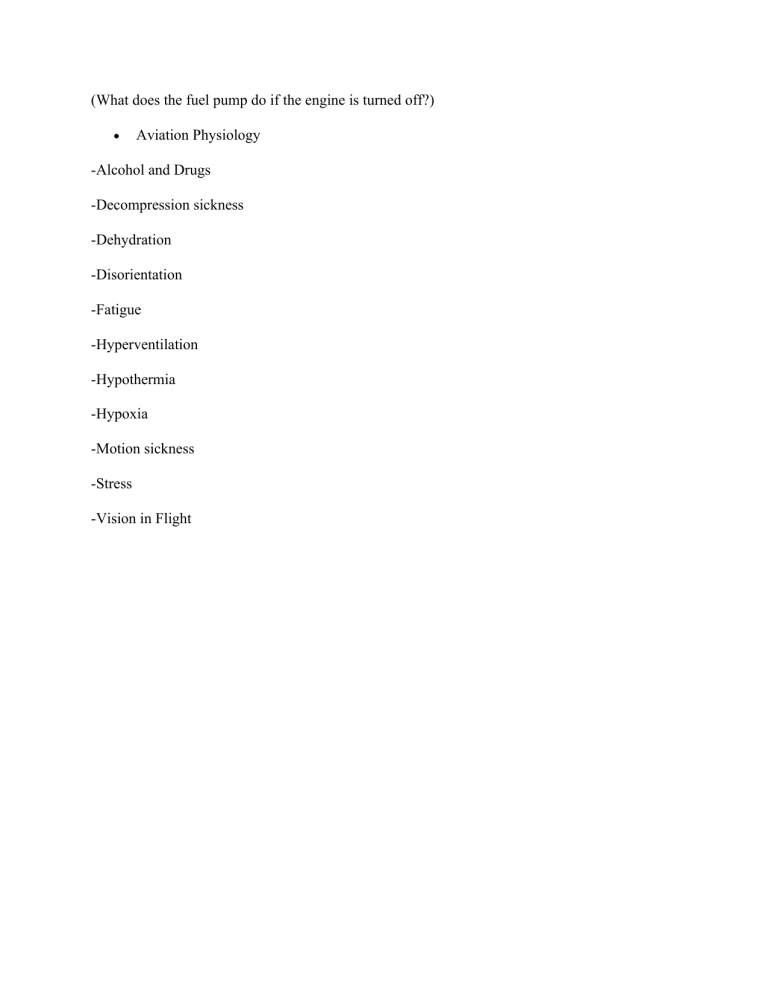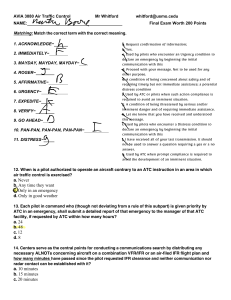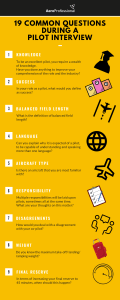
(What does the fuel pump do if the engine is turned off?) • Aviation Physiology -Alcohol and Drugs -Decompression sickness -Dehydration -Disorientation -Fatigue -Hyperventilation -Hypothermia -Hypoxia -Motion sickness -Stress -Vision in Flight • Day/Night Vision (AIM 8-1-6) (day: PHAK 17-19) (night: PHAK 17-22) - Photopic vision (used for seeing color and fine detail) only works with good illumination and utilizes cones - Mesopic vision (experienced at dawn and dusk) is the most dangerous because it uses rods and cones, but the cones become less effective and pilots need to shift their scanning techniques - Scotopic Vision (low-light levels) utilizes rods and color perception is lost and there is a night blind spot where the cones are focused - Empty-Field Myopia- occurs when flying above clouds, this causes the eyes to relax and pilots to “look without seeing” (very dangerous) - Takes approximately 30 minutes for eyes to become dark adapted due to rods taking longer to adjust than cones - Night Blind Spot: rods are utilized for night vision, but they are more used for peripheral vision, this can lead to a “blind spot” in the middle of vision. To correct for this, looking 5-10 degrees off center can help to see an object. - Maintaining night vision: sunglasses, oxygen (night vision declines starting above 4,000 feet), lowering flightdeck lighting, - drugs, exhaustion, stress, and alcohol can all lead to worsened night vision. • Visual Illusions (PHAK 17-8) (AIM 8-1-5) “Under normal flight conditions, when there is a visual reference to the horizon and ground, the sensory system in the inner ear helps to identify the pitch, roll, and yaw movements of the aircraft. When visual contact with the horizon is lost, the vestibular system becomes unreliable.” “A pilot can reduce susceptibility to disorienting illusions through training and awareness and learning to rely totally on flight instruments.” False Horizon: When something, like sloping clouds, makes a pilot see a “false horizon” and the attempt to align the aircraft can lead to a dangerous flight attitude. Rely on instruments to solve this Autokinesis: A stationary light may appear to start moving, and the pilot may attempt to align the aircraft. To solve, do not fixate on one object, scan the sky. Runway Illusions: -Narrow runway, upsloping, featureless terrain, haze/fog, or a runway with few lights can all make a pilot feel higher than they actually are and therefore fly a lower approach • Spatial Disorientation (PHAK 17-9) This can occur when doing different maneuvers such as: Climbing while accelerating Climbing while turning Diving while turning To prevent: use reliable visual references, avoid sudden head movement, and rely on flight instruments rather than sensory perceptions • High Altitude Operations - Flying at high altitudes consumes less fuel for different airspeeds, and it allows for weather avoidance (PHAK 7-34) - 91.211: No person may operate a US-registered civil aircraft at cabin pressure altitudes above: A. 12,500’ MSL up to/including 14,000’ unless the required minimum flight crew is provided with and uses supplemental oxygen for the part of the flight at those altitudes that is over 30 min. B. 14,000’ unless the required minimum flight crew is provided with and uses supplemental oxygen during the entire flight time at those altitudes. C. 15,000’ unless each occupant of the aircraft is provided with supplemental oxygen. 2. No person may operate a civil aircraft of a US-registered aircraft with a pressurized cabin at flight altitudes above: A. FL 250 unless at least a 10 min supply of supplemental oxygen is available for each occupant of the aircraft for use in the event that a descent is necessitated by a loss of cabin pressure. i. This is in addition to oxygen required above. B. FL 350, unless one pilot at the controls of the airplane is wearing and using an oxygen mask that is secured and sealed. i. The mask must supply oxygen at all times or automatically supply oxygen whenever the cabin pressure altitude of the airplane exceeds 14,000’ MSL. ii. Exception: One pilot need not wear and use an oxygen mask while at or below FL 410 if there are two pilots at the controls and each pilot has a quick donning type of oxygen mask that can be placed on the face with one hand from the ready position within 5 seconds, supplying oxygen and properly secured and sealed. iii. If one pilot leaves the controls, the remaining pilot shall put on and use an oxygen mask until the other pilot has returned. - Hypoxia (later point) - Decompression sickness—evolving and expanding gases in the body. Trapped gas—expanding/contracting gas in cavities during altitude changes can result in abdominal pain, toothache, or pain in ears and sinuses if the pressure change isn’t equalized. Evolved gas—with a sufficient pressure drop, nitrogen forms bubbles which can have adverse effects on some body issues. Scuba diving compounds this problem. - Vision deteriorates with an increase in altitude due to lack of oxygen • Hypoxia (PHAK 17-3) Hypoxic Hypoxia: -Insufficient oxygen available to the body. Can be caused by an increase in altitude or carbon dioxide which can displace oxygen in the air Hypemic Hypoxia: -Blood is unable to transport oxygen due to “not enough blood”. Can come from anemia, CO poisoning, or blood donation Stagnant Hypoxia: - Blood is unable to flow, can be caused by heart failing to pump blood or excessive Gs’ Histotoxic Hypoxic: - Blood is transporting oxygen, but cells are unable to use it. Caused by drugs and alcohol. Symptoms: Blue fingernails and lips, headache, increased reaction time, impaired judgment, euphoria, visual impairment, drowsiness, lightheaded, tingling, or numbness • Hyperventilation (PHAK 17-4) -The excessive rate of respiration. This causes a loss of carbon dioxide. Can lead to unconsciousness. Has symptoms similar to hypoxia, but the solution is to breathe normally, into a paper bag, or talking aloud • Aeronautical Decision Making (PHAK Ch 2) - A systematic approach to the mental process used by pilots to determine the best course of action • DECIDE Model (PHAK 2-19) • Risk Assessment (PHAK 2-3) • Workload Management (PHAK 2-24, CRM Slideshow) - Utilizing autopilot can help relieve stress in high workload situations. - Prioritize tasks (Critical, Important, Routine) (aviate, navigate, communicate) - Expand your team – Jumpseaters, Deadhead, Dispatch, FAs, ATC, etc. - Delegate tasks - Add Time! How can we add time in flight? Break large tasks into small tasks ATC delays/Holds Slow down • Single-Pilot Resource Management (PHAK 2-13) - Leaning how to think in different situations. Being prepared and organized to handle many things at once • Hazardous Attitudes (PHAK 2-5) • Situational Awareness - Utilization of the PAVE checklist (Pilot, Aircraft, enVironment, and External pressures) can help to maintain good situational awareness - Three Elements: look, think, act - Fatigue, stress, and work overload can cause fixation and a lack of SA • IMSAFE Checklist (PHAK 2-8) - This checklist is utilized to determine physical and mental readiness for flying • 5-P Model (PHAK 2-13) - A practical application of single pilot resource management Plan: basic elements of cross-country planning, weather, route, fuel, publications currency, etc. Plane: include database currency, automation status, and emergency backup systems Pilot: IMSAFE and other human factors Passengers: Pilots also need to understand that non-pilots may not understand the level of risk involved in flight. There is an element of risk in every flight. Programming: unlike the analog instruments they replace, they tend to capture the pilot’s attention and hold it for long periods of time. To avoid this phenomenon, the pilot should plan in advance when and where the programming for approaches, route changes, and airport information gathering should be accomplished, as well as times it should not.



